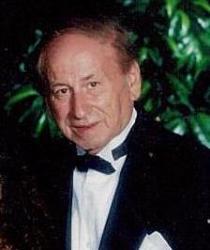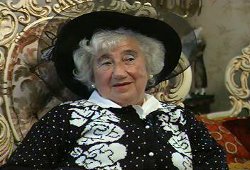 Iran’s Attack on Israel
Iran’s Attack on Israel


7 min read
Fanny and Jerry Goose’s story of surviving the Holocaust.
On the day Fania was born to the Stenbock family in the small Polish town of Skalat, her father planted a tree in their garden to celebrate her arrival. Little did he realize on that day in 1922 that Fania and the little tree would become the only living remnant of his family.
 Fania had a happy childhood, growing into an energetic teenage girl. Then the Nazis invaded Poland and Fania’s joyful life came to an abrupt end. The Jewish community of Skalat was eventually destroyed but through one miracle after another, Fania managed to survive. While many Polish people helped the Nazis achieve their murderous aims, a Polish priest and nuns risked their lives to save her, hiding her in a monastery where she was dressed in appropriate clothing to disguise her Jewish identity.
Fania had a happy childhood, growing into an energetic teenage girl. Then the Nazis invaded Poland and Fania’s joyful life came to an abrupt end. The Jewish community of Skalat was eventually destroyed but through one miracle after another, Fania managed to survive. While many Polish people helped the Nazis achieve their murderous aims, a Polish priest and nuns risked their lives to save her, hiding her in a monastery where she was dressed in appropriate clothing to disguise her Jewish identity.
She was determined to live as a witness to this horrific era for the sake of the Jewish people.
When the war finally ended Fania returned home only to be devastated to find her family and the entire town destroyed.
They were gone. Each and every one of them. My family, the whole district, my entire community. Gone!
Fania describes her shock discovery in her autobiography, Rising from the Holocaust, “They were gone. Each and every one of them. My family, the whole district, my entire community. Gone! Where could I turn, where could I go? I am alone, I thought, alone in the world with no one. A numbing coldness settled on my heart...”
At that heartbreaking moment, she found the small tree planted by her father growing where her family’s home had been. Among its roots, she discovered hidden heirlooms deep in the earth, buried by her vanished family.
Despite her feelings of solitude, the discovery of her tree and the heirlooms gave Fania the courage to rebuild her life. Her determination and faith in God provided her with hope for a better future.
 Not long afterwards, Fania met Jerzy Gusz, a hero from the Jewish underground, the man who would soon become her husband.
Not long afterwards, Fania met Jerzy Gusz, a hero from the Jewish underground, the man who would soon become her husband.
Born in 1919 in Berezno, Poland, Jerzy was the youngest of 11 children. His father was a successful butcher who supplied the militaryand they lived in a large house. When the Germans invaded Poland in 1942, their home was bombed. The parents, sheltered in the basement, survived. Jerzy and one nephew also survived but all the rest of the family were killed in the bombing. They were eventually sent to the Berezno ghetto until the Nazis rounded up most of the Jews for transport to the various death camps. Jerzy’s parents were killed on the spot.
We had nothing to lose – we lived like we were dying tomorrow.
Jerzy fled to the forest and joined the Ukrainian Partisans. In an interview with the Shoah Foundation, Jerzy described what happened to him. “I hid my Jewish identity and they welcomed me because I could butcher their meat. After a year, they lost many skirmishes against the Germans and they disbanded. I escaped to another forest in Western Poland and when I heard people speaking Yiddish, I joined them and we created a Jewish Partisan Group. We had nothing to lose – we lived like we were dying tomorrow. We were liberated by the Russians in March, 1944. Then I was taken into the Russian Army in their Polish division and sent to the front. Ukrainian Nazi sympathizers attacked my division and I was shot in the hand. I lost two fingers and taken to a hospital in Kiev. In October, 1944, I was released and sent to a rehabilitation hospital in Russian-occupied Germany.”
 Jerzy described how he met his wife. “While changing trains at a train station in Skalat, a young bookkeeper by the name of Fania, who happened to be at the train station paying some company bills, glanced at me and thought I looked Jewish. I have no memory of her, but a few months later I happened to be in Skalat for a day and went into the bank where Fania worked and she recognized me right away. She knew that a soldier had freedom of movement, and she asked if I could help get her to the American zone. I told her that I couldn’t take her unless she was my sister, or my wife. She said ‘Okay, I can be your wife.’ I agreed and we made the arrangements.
Jerzy described how he met his wife. “While changing trains at a train station in Skalat, a young bookkeeper by the name of Fania, who happened to be at the train station paying some company bills, glanced at me and thought I looked Jewish. I have no memory of her, but a few months later I happened to be in Skalat for a day and went into the bank where Fania worked and she recognized me right away. She knew that a soldier had freedom of movement, and she asked if I could help get her to the American zone. I told her that I couldn’t take her unless she was my sister, or my wife. She said ‘Okay, I can be your wife.’ I agreed and we made the arrangements.
Like many other Shoah survivors whose families had been wiped out, they were both eager to marry and start a new family. On May 15, 1945, Fania’s cousin Rabbi Moshe Shechter performed the Jewish marriage ceremony.
“Our son, Martin, was born February 21, 1946. We travelled throughout Germany until 1949. In Hamburg we got papers to travel to either the US or Canada. My maternal uncle, Abe Raybur, guaranteed me a job in his leather factory in Winnipeg so we boarded a boat to Canada. In August, 1949, we went to Toronto to see Fania’s aunt before we travelled to Winnipeg. Her aunt went to the Jewish Congress and found out that Rabbi Kirshenbaum from the town of London, Ontario could arrange a butcher job for me. In 1950, we bought a panel truck and started J. Goose Family Clothing. Our son, Steven, arrived in 1954."
The couple chose new Anglicized names for themselves: Fanny and Jerry Goose. Like the small tree her father had planted continued to survive and grow, Fanny and Jerry rebuilt their lives after the war. From the difficult beginning of selling clothing to farmers from their panel truck to opening the first J. Goose Family Clothing store, Jerry and Fanny worked hard to build a well-known retail business in London, Ontario and they prospered.
 Becoming respected members of their community, Fanny even became politically influential. She assisted many other refugees and immigrants, happy that her position as storekeeper enabled her to play that role. Doling out advice to immigrants, she had a pay-when-you-can attitude toward those less fortunate. Her compassion earned her the nickname ‘Mother Goose.’ "Every day I found happiness. Every day I could do something good for someone," she said.
Becoming respected members of their community, Fanny even became politically influential. She assisted many other refugees and immigrants, happy that her position as storekeeper enabled her to play that role. Doling out advice to immigrants, she had a pay-when-you-can attitude toward those less fortunate. Her compassion earned her the nickname ‘Mother Goose.’ "Every day I found happiness. Every day I could do something good for someone," she said.
"Fanny and I have created a beautiful family,” said Jerry. They had two sons, Martin and Steven, three grandchildren and two great-grandchildren. “All have gone on to build families of their own. We built a successful business.”
Hitler took away most of my family and my freedom, but he did not take away my faith.
Jerry attributes his steadfast belief to surviving. “I remain a deeply religious man, who put on tefilin and davened every day and made the shul and Judaism the center of my life. Hitler took away most of my family, he took away my freedom, and he took away what should have been the best days of my young life. But he did not take away my faith, and that is why I remained a survivor."
Jerry and Fanny were participants in Steven Spielberg’s Shoah Foundation where they gave video testimony documenting their personal account of the Holocaust. In 2004, Jerry and Fanny were honored by the Jewish National Fund for their dedication to their community of London, Ontario.
Jerry died in 2012 at the age of 92. He and Fanny had been married for almost 67 years. In tribute, one of the many people touched by the family’s kindness, wrote: “I remember Jerry's deep and penetrating eyes, the kind of eyes that have seen too much in one lifetime. Such kindness, patience and gentleness. He was the perfect balance for Fanny’s outgoing, spirited personality.”
Another one of their generous legacies is the Jerry and Fanny Goose Library in Toronto with thousands of books in five languages.
Fanny finally retired from business after many years, wrote her autobiography and keeping up with the times, she even has a facebook account.
